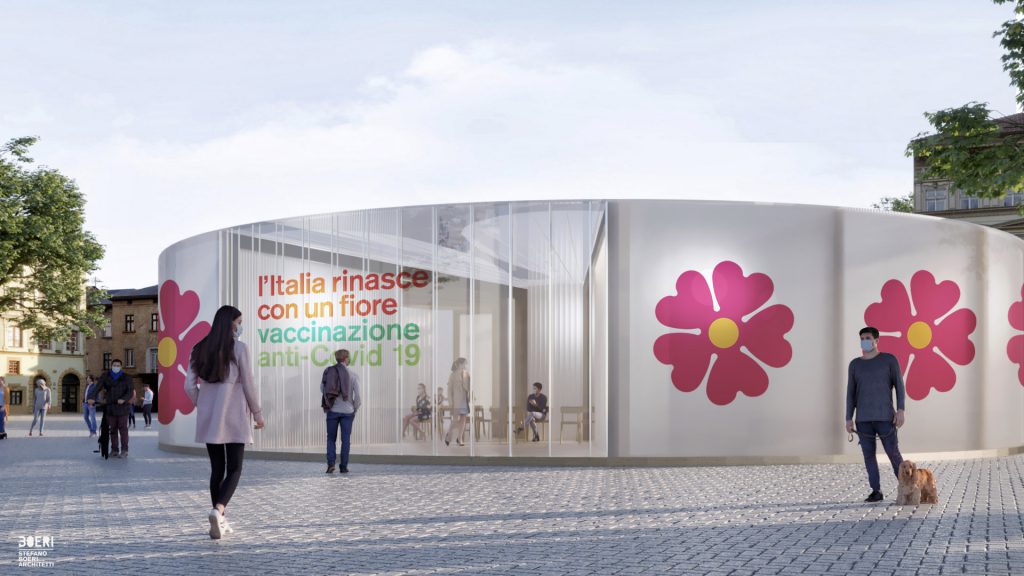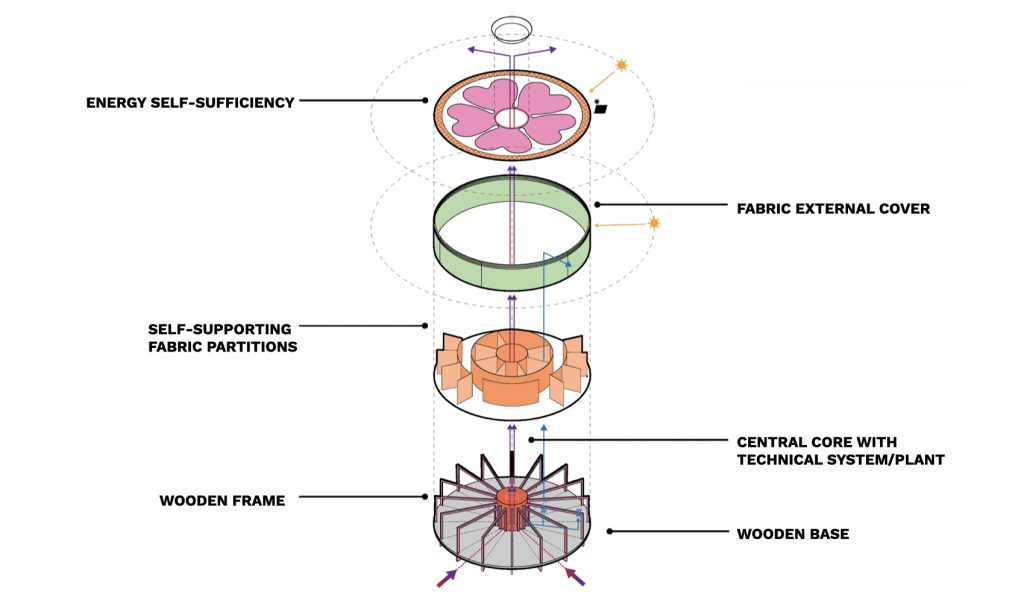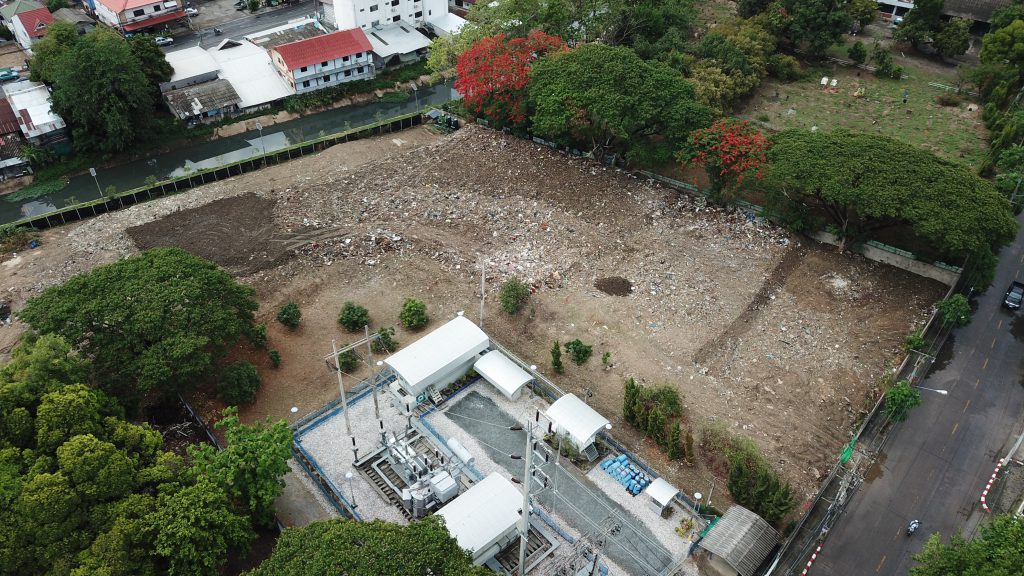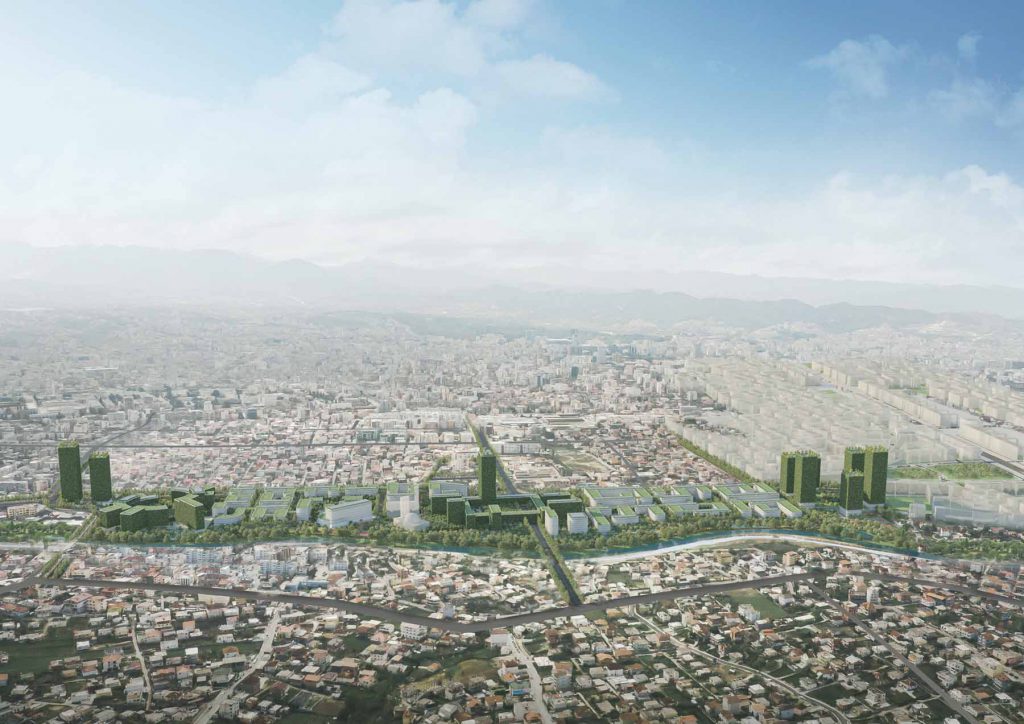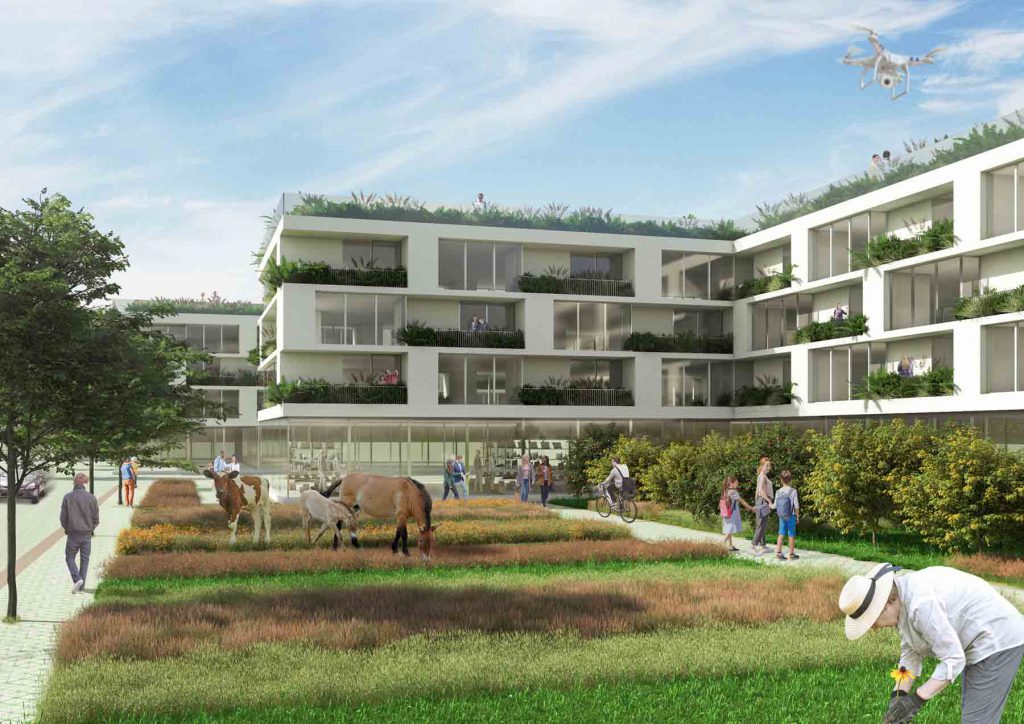With no end in sight when it comes to our battle with future novel diseases, it is the right time for us to review how humans’ endeavors to cope with COVID-19 have shaped the state of New Normal and its influences on the way one lives, including some of the possible dimensions in the way we think about and design architecture and cities.
Text: Supreeya Wungpatcharapon
Download the online journal Issue 01 The ComfortZone Click here
ตั้งแต่โลกได้เผชิญกับโรค Covid-19 และมาตรการเว้นระยะห่างทางสังคม (Social Distancing) มาตั้งแต่ปลายปี 2562 ส่งผลต่อพฤติกรรมการใช้ชีวิตของเราที่ต้องปรับตัวไปอย่างมากในช่วงที่ผ่านมา โดยเฉพาะคนในเมืองใหญ่ซึ่งนอกจากจะได้รับผลกระทบทางด้านสุขภาพเนื่องจากพื้นที่ความเป็นอยู่หนาแน่นในเมืองที่เสี่ยงต่อการแพร่ระบาดของโรคในหลายระลอกแล้วนั้น ยังได้รับผลกระทบด้านเศรษฐกิจและสังคมค่อนข้างสูงอันเนื่องมาจากมาตรการต่างๆในการควบคุมโรค จากวิกฤตการณ์ที่ผ่านมานี้ปฏิเสธไม่ได้เลยว่าเราได้เห็นความสัมพันธ์ของมิติทางสังคมและพื้นที่ทางกายภาพที่เชื่อมโยงกันอย่างแยกไม่ออก และในเมื่อเรายังไม่สามารถนิ่งนอนใจได้ว่าจะมีโรคอุบัติใหม่อื่นๆเกิดขึ้นอีกหรือไม่ในอนาคต คงถึงคราวจำเป็นที่เราจะทบทวนดูว่าการรับมือกับ COVID-19 ที่ผ่านมานั้นส่งผลต่อวิถีใหม่อย่าง New Normal ทั้งการใช้ชีวิตประจำวันของเราและวิธีคิดใหม่ในการออกแบบสถาปัตยกรรมและเมืองในมิติใดบ้าง
เริ่มต้นที่พื้นที่อยู่อาศัยซึ่งเป็นพื้นที่ใกล้ตัวเราที่สุด แต่เราอาจพบว่าในช่วงของการกักตัวและทำงานอยู่ที่บ้านตลอดเวลาทั้ง 24 ชั่วโมงสำหรับบางคนและบางครอบครัวนั้นกลับเป็นสิ่งที่ไม่คุ้นเคย เราอาจมีมุมมองและความต้องการของบ้านในอนาคตที่เปลี่ยนแปลงไป ตั้งแต่พื้นที่เข้าบ้านที่ต้องอำนวยความสะดวกในการสร้างสภาวะปลอดเชื้อให้ได้มากที่สุดอาจส่งผลต่อลำดับการเข้าถึงของพื้นที่ในการออกแบบบ้านในอนาคต หรือระเบียงคอนโดทั่วไปซึ่งเป็นพื้นที่เดียวในบ้านทางตั้งที่เสมือนเราได้อยู่ภายนอกอาคารแต่ที่ผ่านมากลับออกแบบให้มีขนาดเพียงพอสำหรับพื้นที่ซีกรีดเท่านั้น พื้นที่เปลี่ยนผ่านหรือ Transitional space เหล่านี้กลายเป็นพื้นที่ที่เราต้องให้ความสำคัญมากขึ้นหรือไม่มากกว่าจะเป็นเพียงทางผ่านเข้าออกระหว่างภายนอกและภายในบ้าน โดยคำนึงถึงทั้งความสะอาด สุขอนามัย การระบายอากาศธรรมชาติและการเพิ่มพื้นที่ส่วนตัวสำหรับการใช้ชีวิตประจำวันที่เชื่อมต่อกับพื้นที่โล่งภายนอกอาคารมากขึ้น
นอกจากนี้ เมื่อสมาชิกทุกคนในครอบครัวต้องอยู่ร่วมกันตลอดเวลาทั้งวันในขณะที่กิจกรรมประจำวันทั้งการเรียน ทำงาน และการประชุมออนไลน์ต้องการพื้นที่รองรับความเป็นส่วนตัวของทุกสมาชิกได้พร้อมกันนั้น ที่พักอาศัยขนาดเล็กทั่วไปดูจะไม่สามารถตอบโจทย์ได้มากนัก การออกแบบที่พักอาศัยจึงต้องการความยืดหยุ่นของพื้นที่เพื่อการปรับเปลี่ยนรองรับพฤติกรรมหลากหลายของทุกสมาชิกได้อย่างจริงจังมากขึ้น แนวคิด Resilient Home โดยบริษัทออกแบบในออสเตรเลียอย่าง WOODS BAGOT นำเสนอการออกแบบห้องชุดพักอาศัย AD-APT ที่ยืดหยุ่นปรับเปลี่ยนพื้นที่การใช้งานได้หลายรูปแบบในระหว่างวัน เพื่อรองรับกิจกรรมที่เกิดขึ้นเมื่อทั้งครอบครัวอยู่ที่บ้านพร้อมกัน ด้วยแนวคิดของพื้นที่บ้านที่ยืดหยุ่นนี้เราสามารถจัดเป็นพื้นที่ปลอดเชื้อที่รองรับการกักตัวของสมาชิกในบ้านที่มีความเสี่ยงในการแพร่ระบาดของโรคติดต่อ หรือจะประยุกต์ใช้รองรับการดูแลผู้สูงวัยในบ้านในอนาคตได้อีกด้วยเมื่อถึงคราวจำเป็นแม้จะไม่มีสถานการณ์ของโรคระบาดก็ตาม
การออกแบบพื้นที่สำนักงานแบบผังพื้นเปิดโล่งและการสร้างพื้นที่ทำงานเป็นทีมร่วมกันอย่างใกล้ชิดได้รับความนิยมค่อนข้างสูงในช่วงหลายปีที่ผ่านมา แต่การมาถึงของไวรัสโคโรน่าและมาตรการเว้นระยะพื้นที่ระหว่างกันอย่างน้อย 2 เมตรนั้นส่งผลต่อการจัดการพื้นที่ภายในสำนักงานและรูปแบบที่ปรับมาสู่การทำงานจากทางไกลหรือ Work from Home ซึ่งในภายหลังพบว่ามีความเป็นไปได้สูงขึ้นที่จะเป็นวิถีใหม่ของการทำงานนั้น อาจทำให้เราต้องเริ่มคิดทบทวนใหม่ถึงรูปแบบของการออกแบบสำนักงานในอนาคต มีการคาดการณ์ว่าในบางองค์กรนั้นอาคารสำนักงานหลักอาจจะมีขนาดเล็กลงแต่มีให้ความสำคัญกับคุณภาพของพื้นที่มากขึ้นในการสร้างบรรยากาศการทำงาน แรงบันดาลใจ และกระตุ้นความคิดสร้างสรรค์ หรือพื้นที่ของสำนักงานอาจจะเน้นการกระจายตัวเป็นจุดย่อยไปตามพื้นที่ในเมืองผสานกันหลายทางเลือกให้แก่บุคลากรขององค์กร ทั้งในลักษณะการ Work from Home หรือการให้ความสำคัญกับพื้นที่กิจกรรมในลักษณะ On-demand event spaces หรือ Third-spaces มากขึ้น ตลอดจนการพัฒนาให้เกิดพื้นที่ทำงานแทรกไปตามพื้นที่ชุมชน Local community hubs
งานวิจัย Public Space, Public Life, and COVID 19 ของ Gehl Architects ในเมืองโคเปนเฮเกนและอีกสามเมืองในเดนมาร์ก ชี้ให้เห็นว่าพื้นที่พบปะทางสังคมกับผู้คนและชุมชนยังคงเป็นสิ่งที่เราโหยหาในช่วงเวลาของการเว้นระยะห่างทางกายภาพ นักออกแบบในหลากหลายสาขาต่างพยายามนำเสนอแนวคิดการออกแบบพื้นที่ทางสังคมที่เราสามารถใช้ชีวิตร่วมกันได้ในเมืองแต่ยังคงอยู่อย่างปลอดภัยทางกายและสบายทางใจได้
เช่นงานออกแบบสวนสาธารณะ Parc de la Distance โดย Studio Precht ในออสเตรียที่นำเสนอเส้นทางเดินส่วนตัวในสวนกลางเมืองที่เราสามารถรักษาระยะห่างทางกายภาพจากคนอื่นๆแต่ยังรู้สึกถึงธรรมชาติและรับรู้บรรยากาศของคนเมืองที่เดินอยู่ในสวนด้วยกันได้
อีกหนึ่งตัวอย่างผลงานออกแบบจากสตูดิโอ Colab-19 ที่เพิ่งก่อตั้งขึ้นเมื่อช่วงกลางปี 2563 ท่ามกลางสถานการณ์โรคระบาดในโคลอมเบีย โดยสถาปนิกให้ความสนใจในการออกแบบพื้นที่สาธารณะทางตั้งขึ้นในเมืองโบโกต้าช่วงที่มาตรการเว้นระยะทางราบยังคงเข้มงวดแต่เศรษฐกิจของเมืองยังต้องขับเคลื่อนต่อ ด้วยการดึงคนออกมาใช้ชีวิตนอกบ้านทั้งการจับจ่ายใช้สอยและกิจกรรมสังสรรค์กลางแจ้งเพื่อความผ่อนคลาย พวกเขาจึงเสนอการออกแบบพื้นที่สาธารณะภายนอกบ้านใหม่ในทางตั้งที่เอื้อต่อ Vertical distancing ด้วยการติดตั้งโครงสร้างนั่งร้านมาดัดแปลงใช้กับอาคารรูปแบบต่างๆขึ้น ข้อดีของนั่งร้านคือราคาไม่สูง ดัดแปลงได้ สร้างได้เร็วและรื้อถอนได้ง่าย และช่วยเอื้อให้สามารถรองรับคนในจำนวนเท่าเดิมหรือเพิ่มขึ้นแม้ต้องรักษาระยะห่างระหว่างกัน โดยเขาสร้างผลงานออกแบบจริงในหลากหลายรูปแบบทั้งตลาด สวนลอยฟ้า โรงละครกลางแจ้ง หรือพื้นที่พิธีกรรมทางศาสนา โดยผู้ออกแบบพยายามเน้นความสำคัญของการสร้างความร่วมมือกับหน่วยรัฐท้องถิ่นและภาคเอกชนในการร่วมทำงานให้ผ่านวิกฤตไปด้วยกัน
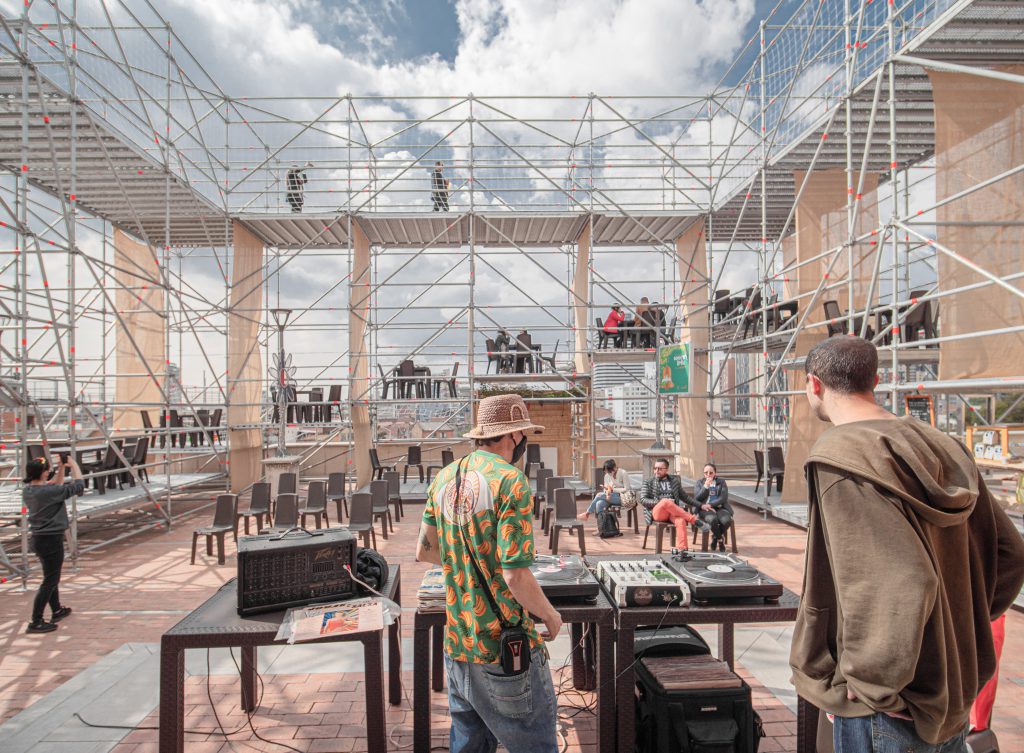
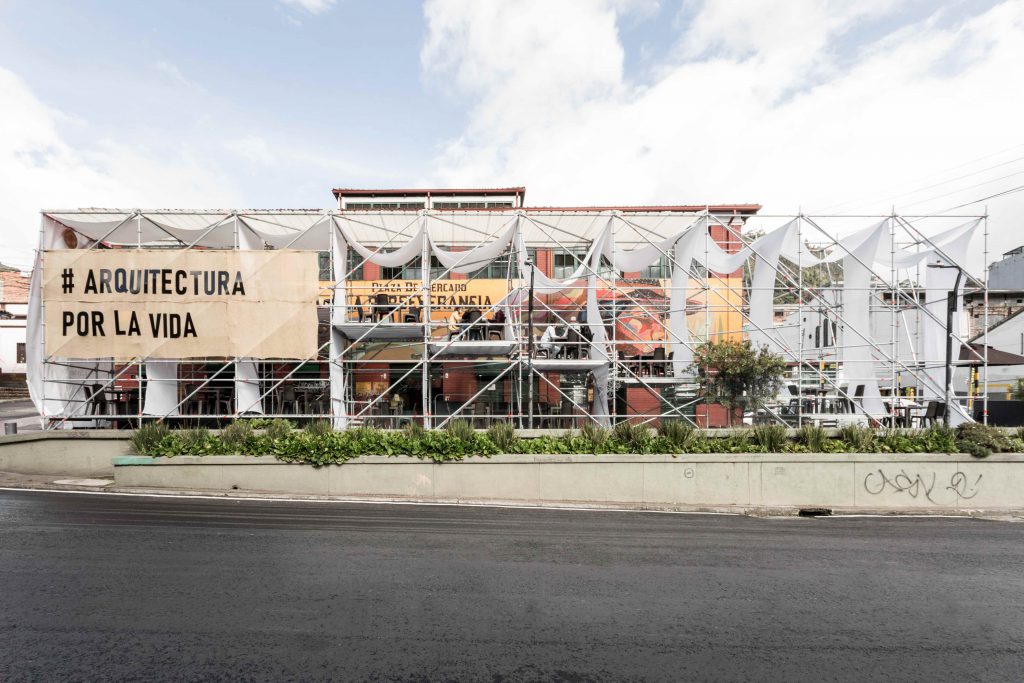
Images are courtesy of COLAB-19
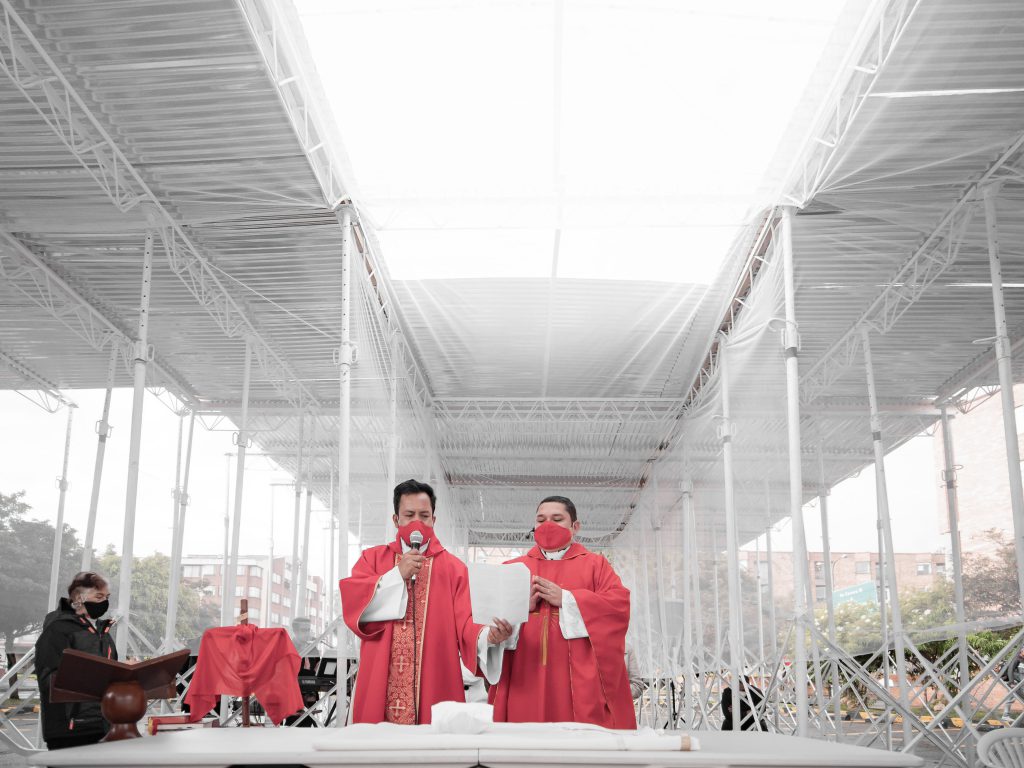
Images are courtesy of COLAB-19
นอกจากโรงพยาบาลที่ต้องรับมือกับการรักษาพยาบาลผู้ป่วยในช่วงการระบาดของ COVID-19 ที่ผ่านมา ยังมีพื้นที่เกี่ยวกับการรักษาพยาบาลในรูปแบบเฉพาะหน้าเกิดขึ้นเพื่อตอบรับสถานการณ์ที่ต้องรองรับผู้ติดเชื้อจำนวนมาก เช่นในหลายๆเมืองปรับพื้นที่สนามกีฬาในร่มให้เป็นทั้งโรงพยาบาลสนามหรือพื้นที่สำหรับฉีดวัคซีนป้องกันโรคแก่คนจำนวนมาก
ในบางเมืองเลือกการปรับใช้ลานจอดรถสำหรับการให้บริการฉีดวัคซีนแบบ Drive through เพื่อช่วยลดการรวมคนมาใช้พื้นที่รออยู่ร่วมกันจำนวนมากในอาคาร สถาปนิกจากบริษัท Stefano Boeri ในอิตาลีกลับต้องการเสนอสถาปัตยกรรมใหม่ในโครงการ Anti COVID-19 Vaccination Campaign เพื่อรับรองการฉีดวัคซีนที่สื่อถึงสัญลักษณ์ของการฟื้นคืนตัวใหม่ด้วยภาพลักษณ์ของดอกไม้บานในฤดูใบไม้ผลิ โดยพยายามสะท้อนว่าหากไวรัสโคโรนาขังเราไว้ในโรงพยาบาลและบ้านเป็นระยะเวลาปีกว่าที่ผ่านมา วัคซีนจะทำให้เรากลับมาสัมผัสกับชีวิตและธรรมชาติที่อยู่รอบตัวเราอีกครั้ง

ในผลงานออกแบบจึงเป็นการนำเสนอแบบบูรณาการของสามองค์ประกอบคือ โลโก้ในรูปแบบต่างๆ การออกแบบสำหรับศาลาชั่วคราวเพื่อใช้ในการฉีดวัคซีนตามลานคนเมืองหลักในอิตาลี และข้อมูลมือถือเพื่อการสื่อสารในพื้นที่สาธารณะของเมือง โดยผลงานออกแบบสถาปัตยกรรมชั่วคราวของ Boeri เป็นศาลาวงกลมตั้งอยู่บนฐานไม้สำเร็จรูปคลุมด้วยผ้าที่ผสมผสานจากวัสดุกันน้ำที่สามารถย่อยสลายได้ตามธรรมชาติและรีไซเคิลได้ ส่วนหลังคามีระบบแผงเซลล์แสงอาทิตย์ที่ออกแบบมาเพื่อผลิตกระแสไฟฟ้าให้เพียงพอกับความต้องการของศาลาทั้งหมด สำหรับที่ว่างภายในจะถูกแบ่งกั้นด้วยผนังจากระบบสิ่งทอสำเร็จรูปที่โดดเด่นในด้านน้ำหนักเบา ยืดหยุ่น สามารถดูดซับเสียงและมีความโปร่งใส การจัดผังพื้นที่ภายในของศาลาประกอบด้วยที่ว่างสำหรับการฉีดวัคซีนและพื้นที่สำหรับพักรอทั้งก่อนและหลังจากการฉีด ในขณะที่แกนกลางของวงกลมออกแบบไว้สำหรับพื้นที่ทำงานของผู้ปฏิบัติการทางการแพทย์ ซึ่งจากข้อเสนอของเขาทางรัฐบาลท้องถิ่นอิตาลีนำมาดำเนินการจริงในการสร้างพื้นที่เพื่อการฉีดวัคซีนให้กับประชาชนต่อไป
Images credits: www.stefanoboeriarchitetti.net Images credits: www.stefanoboeriarchitetti.net
เมื่อเกิดการแพร่ระบาดลุกลามจนนำไปสู่การ Lockdown ปิดการเดินทางระหว่างเมืองนั้น แต่ละเมืองเริ่มต้องคิดถึงการพึ่งพาทรัพยากรภายในเมืองของตัวเองมากขึ้นโดยเฉพาะแหล่งอาหารปลอดภัย พื้นที่ความมั่นคงทางอาหารจึงเป็นอีกหนึ่งความจำเป็น
ในโครงการ สวนผักคนเมืองเชียงใหม่ ในย่านช้างคลานที่ริเริ่มเมื่อกลางปี 2563 หลังจากการประกาศ Lockdown ครั้งแรกในประไทยที่คนเมืองโดยเฉพาะชุมชนผู้มีรายได้น้อยได้รับผลกระทบจากการหยุดงาน ส่งผลต่อรายได้และการประทังชีวิตของครอบครัวตามมานั้น ด้วยความร่วมมือของภาคีเครือข่ายในเมืองเชียงใหม่ ชุมชนริมคลองแม่ข่า และหน่วยงานรัฐในท้องถิ่น รวมถึงกลุ่มสถาปนิกจาก ใจบ้านสตูดิโอ ที่สนับสนุนด้านการออกแบบวางผัง จึงเริ่มโครงการพัฒนาพลิกฟื้นที่ว่างทิ้งขยะเดิมของเทศบาลขนาด 3 ไร่ แปลงเป็นสวนผักของชุมชนและพื้นที่สาธารณะสีเขียวให้แก่คนเมืองเชียงใหม่ ผ่านกลไกทำงานที่ออกแบบไว้เพื่อสร้างความพึ่งพาอาศัยและเกิดประโยชน์แก่คนหลายกลุ่มอย่างทั่วถึง โดยชุมชนที่เดือดร้อนจากการระบาดของ COVID-19 จะได้รับการแบ่งปันอาหารจากการลงแรงผลิตอาหารปลอดภัยบนพื้นที่รกร้างของรัฐ ภาคประชาสังคมและวิชาการมาร่วมให้ความรู้ในการเพาะปลูกและการพัฒนาเป็นพื้นที่เรียนรู้ และผลผลิตที่เหลือสามารถนำไปขายเป็นอาหารปลอดภัยในราคาที่เป็นมิตรแก่คนเมืองเชียงใหม่และเครือข่ายธุรกิจโรงแรมในย่าน โดยส่วนต่างจากการขายกลับคืนมายังชุมชนผู้ผลิตเป็นรายได้อีกทางหนึ่งด้วย
Images are courtesy of JaiBaan Studio Images are courtesy of JaiBaan Studio
ความสัมพันธ์ของเมืองและชนบทเป็นสิ่งที่เห็นความเชื่อมโยงกันในหลายมิติทั้งทางสังคม เศรษฐกิจ และโดยเฉพาะด้านสุขภาวะเมื่อมีการเคลื่อนย้ายของผู้คนที่สัมพันธ์กับการแพร่ระบาดของโรคในหลายระลอก ในหลายเมืองเริ่มมีแนวโน้มที่จะกระตุ้นให้คนเมืองย้ายไปอยู่ในพื้นที่ชนบทมากขึ้น อย่างเช่นที่ไอร์แลนด์มีนโยบายสร้างพื้นที่ทำงานทางไกลกว่า 400 แห่งเป็นส่วนหนึ่งของแผนพัฒนาชนบทระยะยาว 5 ปี โดยบางส่วนเป็นการใช้ประโยชน์อาคารทิ้งร้าง หรือแม้แต่การใช้พื้นที่ของผับบาร์ที่เงียบเหงาในช่วงกลางวันปรับเป็นสถานที่ทำงานทางไกลแทน
ส่วนการออกแบบวางผังเมืองใหม่ๆในอนาคตเองคงต้องคำนึงถึงการรับมือกับวิกฤตต่างๆอย่างใส่ใจมากขึ้น สถาปนิก Stefano Boeri และ SON-Group ร่วมกับรัฐบาลท้องถิ่นในเมืองหลวงของ Albania ร่วมกันออกแบบพัฒนาโครงการ Tirana Riverside สำหรับการอยู่อาศัยของคน 12,000 คนให้ตอบรับกับความเป็นอยู่ที่พึ่งพาตนเองได้ด้านพลังงานและทรัพยากรอาหาร ทั้งยังเน้นความเป็นมิตรต่อสภาพแวดล้อมและการใช้เทคโนโลยีมาสนับสนุนการใช้ชีวิต โดยหวังว่าการอยู่อาศัยในเมืองต้นแบบนี้จะสามารถรับมือกับการใช้ชีวิตในยุคหลัง COVID-19 และสภาวะวิกฤตจากภัยพิบัติทางธรรมชาติหรือการเปลี่ยนแปลงของสภาพภูมิอากาศได้อีกด้วย
การระบาดของ COVID-19 ทั่วโลกในระยะเวลาเกือบสองปีที่ผ่านมานี้ ไม่ใช่เพียงจะสั่นคลอนวิถีความเป็นอยุ่แบบเดิมของเราเท่านั้น แต่อาจเป็นสัญญาณเตือนให้เราได้ตระหนักว่าในอนาคตข้างหน้ายังมีสถานการณ์อื่นที่ไม่คาดฝันเกิดขึ้นได้อีกเสมอที่อาจส่งผลต่อพฤติกรรมและความสัมพันธ์ของเรากับคนรอบข้างกระทบต่อพื้นที่การใช้งานต่างๆในชีวิตประจำวันของเราแบบคาดเดาไม่ได้ เราในฐานะคนเมืองคงจะต้องปรับตัวเองให้ยืดหยุ่นพอที่จะสามารถฟื้นคืนสภาพได้ไวจากทุกสภาวะวิกฤตได้มากขึ้น และในฐานะวิชาชีพสถาปนิกเราจะเริ่มออกแบบการอยู่ร่วมกันวิถีใหม่ในอนาคตข้างหน้ากันอย่างไรในพื้นที่ทางสถาปัตยกรรมทุกประเภท รวมถึงพื้นที่สาธารณะของเมือง
Images credits: www.stefanoboeriarchitetti.net Images credits: www.stefanoboeriarchitetti.net
Since the world’s first encounter with Covid-19, which has led to people’s growing familiarity with social distancing since late 2019, people have been forced to go through a period of transformative change. Urban dwellers are particularly exposed to greater risks due to the density of urban spaces that can worsen the spread of the virus throughout ongoing waves of the pandemic. Meanwhile, social and economic impacts that the state-issued disease control measures have brought upon have been overwhelming if not overbearing.
The crisis has undeniably disclosed the inseparable connection between social dimensions and physical spaces. With no end in sight when it comes to our battle with future novel diseases, it is the right time for us to review how humans’ endeavors to cope with COVID-19 have shaped the state of New Normal and its influences on the way one lives, including some of the possible dimensions in the way we think about and design architecture and cities.
Starting off with residential spaces. While this is the type of space that is collectively elemental to people’s lives, particularly in the post-Corona world, many find that being under quarantine, lockdown or having to work from home, which means spending 24/7 in the space of their own homes, is surprisingly foreign and has been somewhat a struggle. People are now developing different perspectives and needs for their future homes.
Entrance halls are expected to provide the convenience of keeping the house germ-free as much as possible, which can result in the change in the hierarchy of spaces and the design of houses in the future. Another example is balconies in condominium units. The balcony is the only outdoor space in a standard unit of these vertical homes, yet it is designed to have a size sufficient only for one to do their laundry. These transitional spaces have become an element that residential design should put more focus on, rather than treating them as internal walkways that lead dwellers from exit and entryway to different parts of the house. There are matters such as cleanliness, hygiene, natural ventilation and the increase of private spaces that can better accommodate daily usage while being more connected to the external surroundings.
With the situation now forcing families to share their living spaces and having to conduct other daily activities more than ever be there online classes or meetings, living units with relatively less functional spaces cannot simultaneously and effectively offer every family member’s privacy. Residential design needs greater spatial flexibility to adapt to dwellers’ diverse behaviors. Resilient Home is the concept that an Australian-based design company, WOODS BAGOT, proposed for the design of their AD-APT project, distinctive for spatial flexibility and adaptability that can cater to different activities of family members who have to spend time together at home. The flexible modular home concept enables the manipulation of living spaces to provide a part of the house for family members who need to self-isolate themselves when they are considered to be at risk of having and spreading diseases that can be infectious. The design concept can be adapted for a house to accommodate senior family members even without the pandemic.
The design of office spaces with an open floor plan and layout that encourages collaborative work environments was becoming widely popular in the past several years. The arrival of the novel Coronavirus and social distancing measure that puts two-meter space between people has tremendously impacted the allocation of office spaces. New work arrangements include a work-from-home method, which overtime, grows in popularity with the possibility of becoming a mainstream practice. Such a change has caused us to reconsider the future of corporate design. There is speculation that in the future there will be a number of organizations whose head offices will be reduced in size while smaller functional spaces will be maximized in efficiency.
Workspaces with environments that inspire and stimulate creativity will be found scattered at different parts of a city through the work-from-home arrangement including more emphasis that is put on the creation of on-demand activity spaces or Third-spaces. It is postulated that there will be more workspaces emerging as part of local community hubs as well.
A short-length research conducted by Gehl Architects during the lockdown in Copenhagen and other three cities points out that spaces where people can gather and socialize are what most people long for during the period of physical and social distancing. Designers from various disciplines have been trying to propose ideas for the design of social spaces where people, particularly in big cities, can use while ensuring them both physical well-being and mental comfort of being in mass gatherings. One of the examples is the design of Parc de la Distance by Studio Precht in Austria, which proposes the idea of creating personal walkways inside an urban public park where people can practice social distancing while still being able to experience nature and human interactions, where everyone can enjoy the park’s natural surroundings together.
Another interesting example is the project by Colab-19, a design studio freshly established in mid-2020 and in the middle of Columbia’s Corona outbreak. The studio is particularly interested in designing vertical public spaces in Bogota in the time when the city was strictly mandating social distancing measures. The idea is driven by the need to continue to propel the city’s local economy by bringing people outside of their homes, to spend money and support local businesses while lifting each other’s spirits with some social interactions. The design firm proposes the idea for a new format of outdoor public spaces, which enables vertical distancing, with scaffolding structures being applied and installed to different types of buildings.
The upsides of scaffoldings are its relatively affordable, offer convertibility, while the structure is easy to assemble and dismantle. The design can support the same or an increased number of users despite everyone distancing themselves from each other. So far, the design has been constructed into actual structures in the form of a vertical market, an outdoor theater or religious spaces, all carried out as a collaborative effort between the design team, local authorities and the private sector in hopes of overcoming the crisis together.
Besides hospitals being the main battleground for fighting COVID-19, there are temporary healthcare facilities, which are set up to handle the situation where there’s a mass number of admitted patients. There are cities that convert indoor stadiums into field hospitals or mass vaccination facilities. Parking lots are converted into drive-through vaccination points to avoid the gathering of mass crowds inside indoor spaces.
Italian architectural firm, Stefano Boeri, presents a proposal for a new architectural structure as a part of the Anti COVID-19 Vaccination Campaign. The facility will accommodate vaccinations, with the design that symbolizes the recuperation from the pandemic with an image of Primrose, a blooming flower during springtime. The work reflects on how the period of over one year that the Corona virus was keeping people in hospitals and at home, the vaccination is the source that will allow human beings to go back to the lives they used to live, to be able to go outside and return to nature. The design proposes the integration of three different elements: the campaign logo in its various forms, the temporary pavilions used as a vaccine center to be set up in city squares in different main cities in Italy, and the mobile information totem to enable online communication in public spaces. Boeri designs the temporary structure into a circular pavilion with a prefabricated wood structure, which is covered by naturally disposable and recyclable waterproof fabric.
When the virus outbreak leads to a lockdown, inter-city commuting comes to a halt causing each locality to start thinking of ways to be self-sufficient and rely on their own resources, particularly with clean, good quality food. A space that can provide community members food self-sufficiency becomes a necessity.
The Chiang Mai Urban Farm project in Chang Klan district was initiated in the middle of 2020 after Thailand announced its first lockdown. Run by the people living in the area, mostly the community of people with low-incomes who have been financially affected by the lockdown, the project is made possible through a network of communities, groups and local authorities in Chiang Mai including architects from Jai Baan Studio and Klong Mae Kha Canal Community. The municipality’s 1.18-acre deserted landfill has been transformed into a community vegetable garden and public green space.
The project is run by a mechanism designed to equally nurture the reliance and benefits of the people affected by the situation. The community that has been struggling financially due to the pandemic can get their share of the products in exchange for the labor they invested in growing and looking after the garden on the municipality’s deserted land. Networks of civil societies and academics contribute their know-hows in growing and developing the garden into a learning space. The excess produce is sold at a reasonable price, providing the Chiang Mai people and neighborhood hotels with clean, organic vegetables. The money made of the sold products is returned to the community of gardeners and becomes another source of their income.
There are different dimensions involved in the relationship between urban spaces and the countryside, from social, economic and people’s well-being, which is particularly obvious in the time of pandemic when people have had move around and commute, leading to reoccurrence of widespread infections. There have been state-initiated plans designed to motivate more people to live in rural areas. For instance, Ireland has issued a policy that aims to create 400 remote working facilities as a part of the country’s five-year rural development plan. Some of the facilities are converted from deserted buildings or even pubs and bars that see fewer customers during the day since the pandemic hit have been adapted into remote working spots.
Future urban planning puts all these risks into serious consideration. Architecture firms, Stefano Boeri Architetti and SON-Group, together with the local government of Albania’s capital city, has co-designed and co-developed Tirana Riverside. The project, which will accommodate 12,000 residents, is designed to help people lead a self-sufficient lifestyle in regards to fundamental resources such as power and food. It also emphasizes on Eco-friendly practices with technology also incorporated to people’s everyday life. The collaborators hope that this prototype city can help provide people a way to cope with their lives, post-COVID-19, including other natural disasters and crises caused by climate change that they will face in the future.
The global spread of COVID-19 in these past two years has not only shaken people’s way of living to the core, but is also a sign warning mankind to realize that there can always be more unpredictable incidents that will reshape the way people have lived, interacted, and used spaces in everyday life. As an urban dweller, we are now forced to be resilient enough to recuperate from whatever crises that will come our way, faster and more effectively. And as architects, we need to rethink new possible solutions to design architectural and public spaces that will allow humans to coexist under the ‘new normal’ that has been created.


